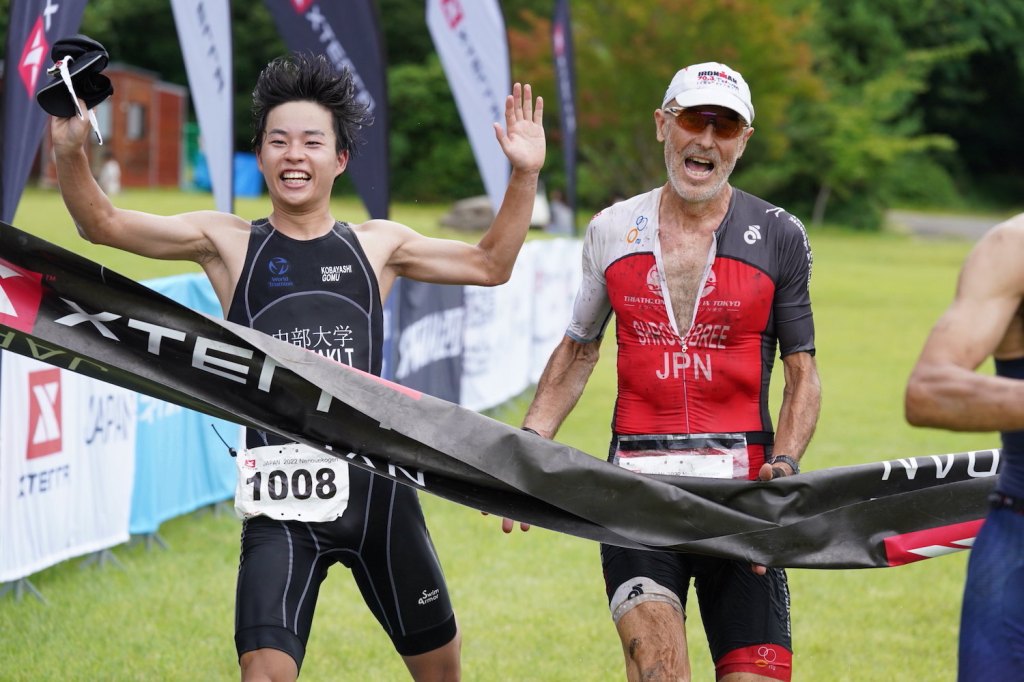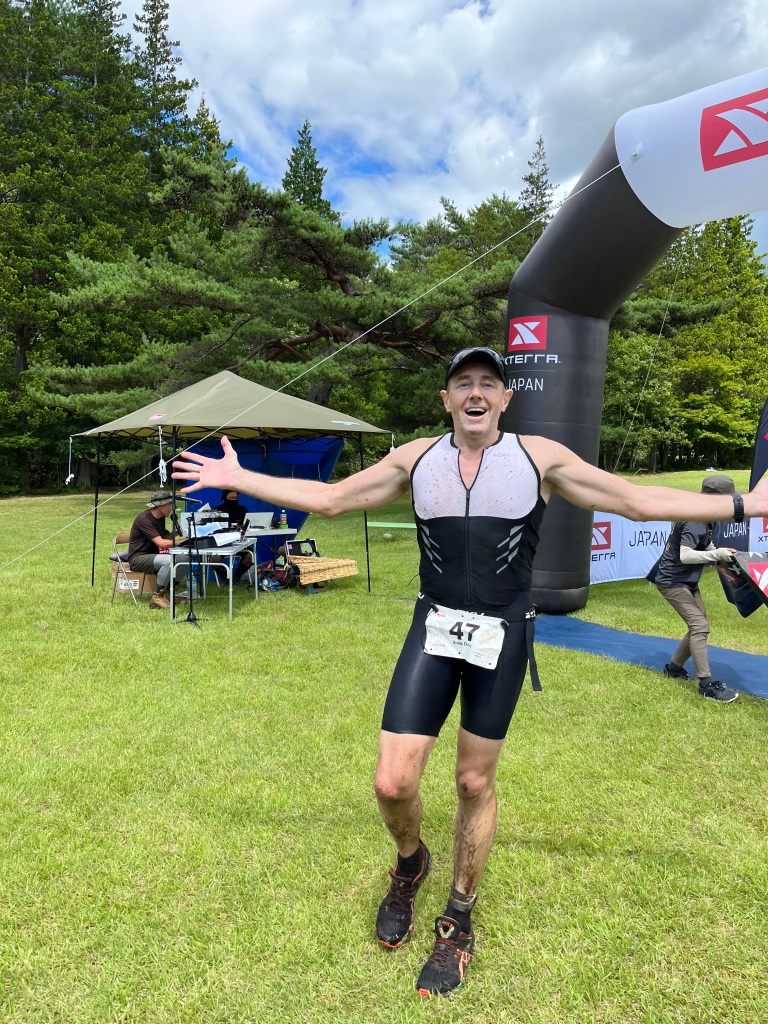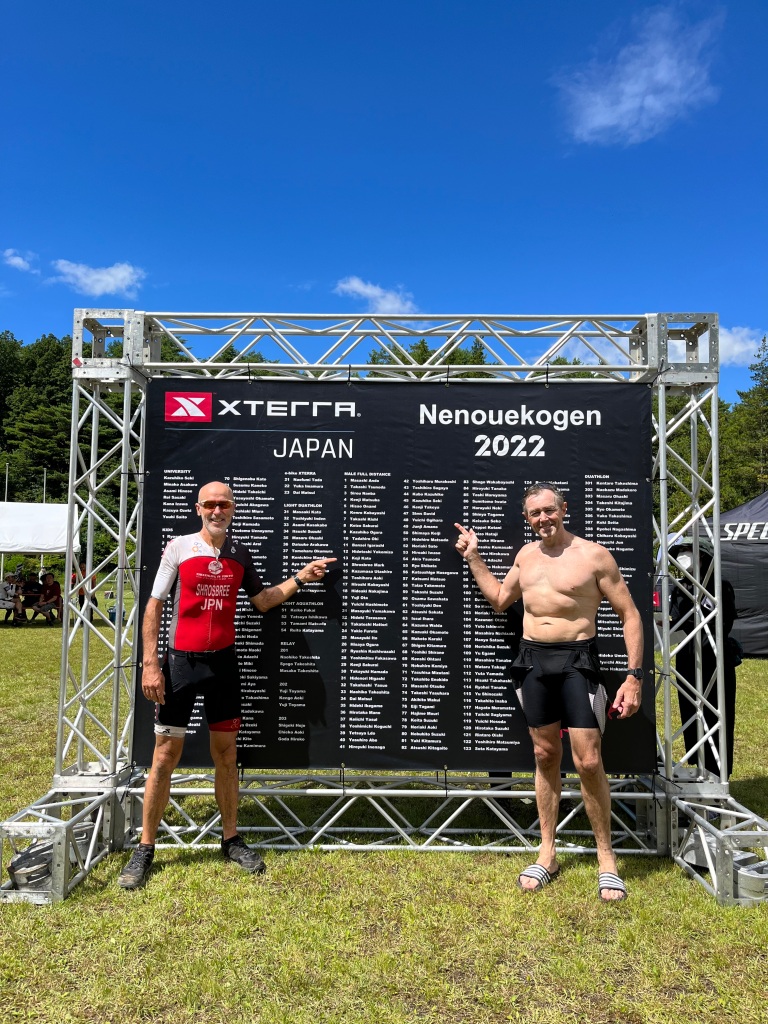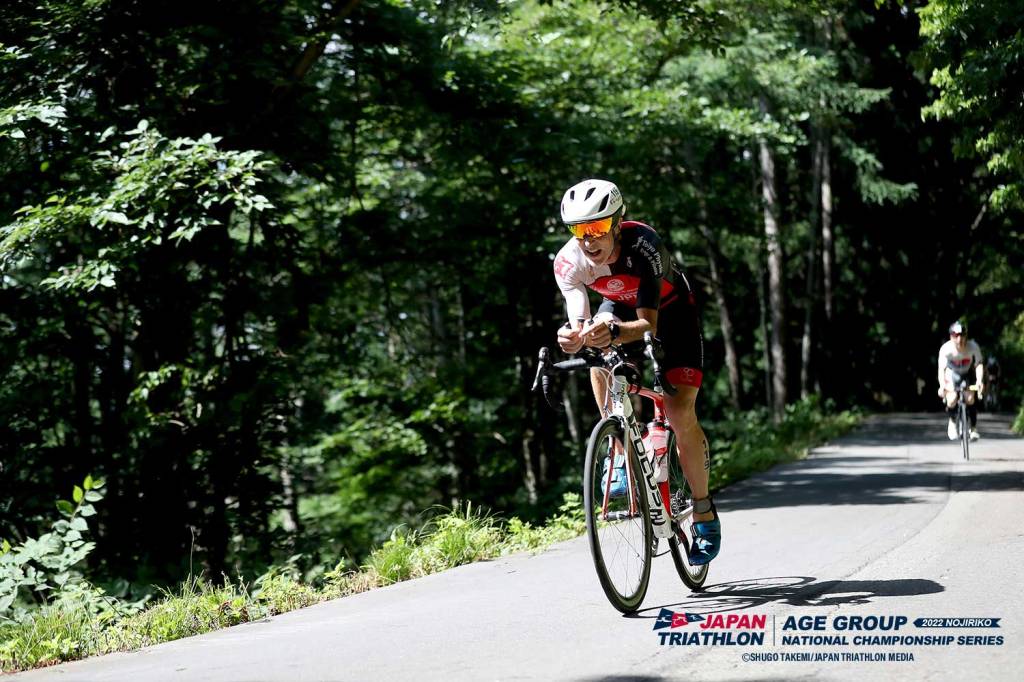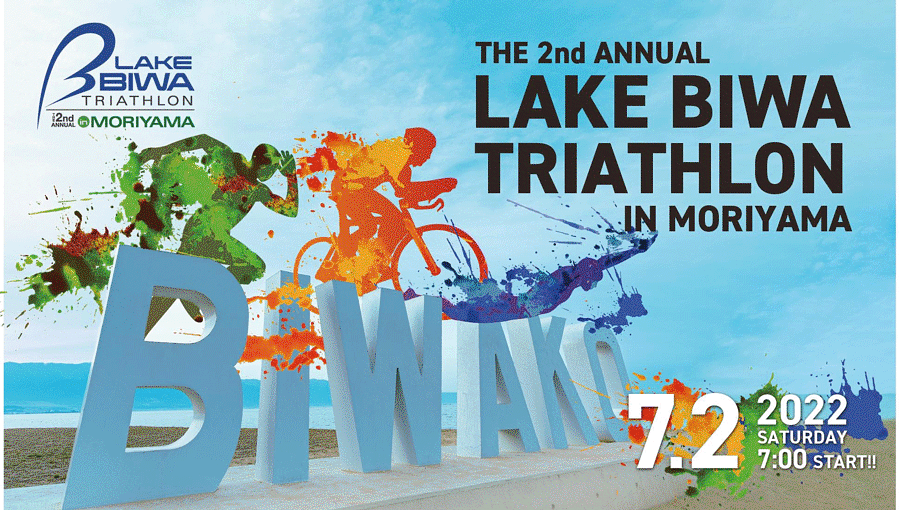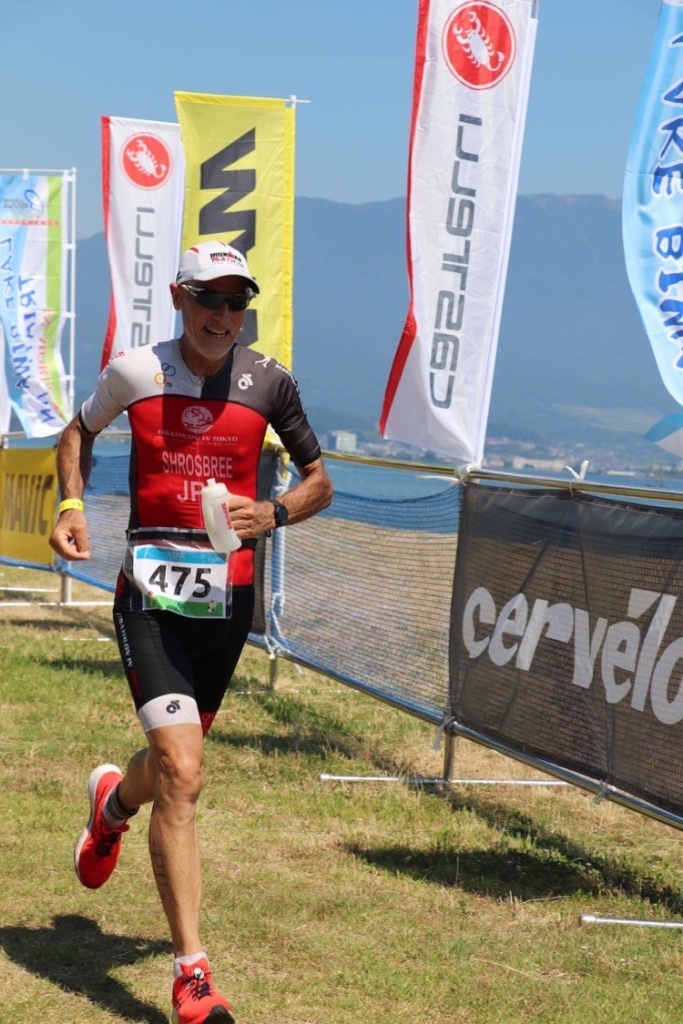
Nenoue Kogen is the kind of place you would never hear of, let alone visit, if it weren’t for a triathlon being held there. It is a high plateau in southern Gifu Prefecture featuring two small lakes and a lot of forest. It is at the southern end of the line of post towns which form waypoints along the ancient road from Tokyo to Kyoto, the Nakasendo. The fact that it is now host to Japan’s second Xterra race is due to the tireless work of one man, Keiji Matsuba, whose passion and commitment to off-road triathlon is boundless. Keiji is a 67-year-old mountain biker trapped in a youth’s body. His skill and strength on the bike would be remarkable at any age but is quite simply breathtaking for someone approaching 70.
I first met Keiji through Olympic distance racing, but he often told me that his real love is Xterra. Not only has he raced Xterra all over the world, including at the world championships in Maui, but he trains off-road all year round in Nenoue Kogen. He can do this as he has a cabin in Nenoue Kogen, as well as a series of trails he has cut around the lakes. For years, he has developed a close relationship with the landowners and gained permission to create his own mountain bike trails, modelled on the best bits of courses he has ridden around the world. The result is a 100% rideable 12-kilometre bike course with every feature you could want to challenge your MTB skills.
Keiji’s work didn’t stop with the bike trail. He also had to persuade the local authorities to allow Xterra to use Nenoue Lake since swimming is not usually permitted there. Then he had to create another trail through the forest for the run. The result is an excellent off-road triathlon in a beautiful highland area, centred on a broad grassy field that overlooks the lake. It is the most beautiful location for a triathlon you could imagine.
I had expected to do the race on my own, but I was unexpectedly joined by Dave Sims, fellow TiTer and oldest friend in Japan. He had just bought a mountain bike for riding around his apartment in Yuzawa, and somehow managed to be persuaded to try an Xterra. I had assured him that the bike course was non-technical, as Keiji had told me it was suitable for all abilities. He must have forgotten what it is like to be a novice rider.
I managed to find an attractive-looking Airbnb in Nakatsugawa, a town on the Nakasendo, and persuaded Miki to once again join me for a few days’ end-of-term break. It is an excellent area for a vacation. We started our holiday there will an unforgettable kaiseki lunch at the atmospheric Nagataki ryokan, followed this with an afternoon walking up and down the restored post town of Magome, and finished with a delightful day exploring the wonderfully historic castle town of Iwamura. When the heat got too much for us, we would return to the old house we had rented with its engawa verandahs overlooking an enclosed garden and large koi pond.
Travelling up to Nenoue Kogen early meant that I could ride the bike course on the Friday and swim in the lake on Saturday. Heavy rain on Thursday night meant that the bike course was wet and muddy for my test run. The boardwalk section around the lake was so slick it was almost impossible to ride, while the numerous tree roots on many of the trails made riding treacherous. I fell several times – not seriously, but enough to make me wonder what would happen when I was racing properly on Sunday.
After my test ride, I got my bike cleaned of all its mud by the race mechanic who had set up a power wash rig with paddling pools supplying the water and a generator providing the power. I also managed to register early, as this is an Xterra race where both the atmosphere and the rules are relaxed. It is nothing like a JTU race.
Sadly, permission to swim in the lake was only granted for the two race days, so I returned early on Saturday for a test swim. The course was a 500-metre triangle, which I swam first in my full wetsuit and then in my sleeveless. I wanted to compare the times, as I have always wondered how much slower it is in a sleeveless wetsuit. For me the answer is 5 seconds per 100 metres. With the water at 28C by the banks and a couple of degrees cooler in the middle, I went for speed over comfort. While taking the water temperature, I felt something biting my toe. It turned out to be a small crayfish.
As I was leaving the race venue, people were arriving for the other races taking place over the weekend, including a sprint distance Xterra, an aquathlon, and an e-bike race. I was surprised to bump into fellow JTU age grouper, Ichikawa-san, who had been persuaded by Keiji to do the race. He looked more than a little apprehensive.
Dave arrived later on Saturday, and I filled him in on what to expect for the race. It was his first off-road triathlon and only his second time ever on a mountain bike. What could possibly go wrong? We then all walked to the excellent Kisaku Italian restaurant for a pre-race feed.
On Sunday morning, Dave and I drove back up to Nenoue Kogen which was truly beautiful in the morning sunshine. We set up our bikes in transition, sat in the shade of a marquee for the race briefing, and waited for our 9 a.m. start. With only 140 people taking part in the full distance race, there was just one wave for the mass start. The atmosphere was remarkably jovial considering what was soon to come.
After my experience in the Nojiriko swim, I placed myself behind the front row of keen swimmers and decided to start off at a very gentle pace. The gun fired and I pootled off with a line of people quickly stretching out in front of me. The water was dead calm – not a breath of wind – but the sun was already hot on my back. My mantra for the first five minutes was to stay as calm as the water and then think about racing later. It worked a treat. I gradually got into the flow of things and found myself working my way around slowing swimmers. At a couple of places, the water was so shallow I hit the bottom, but we had been told in the briefing not to walk, so I just kept going. My second and third laps were a little faster than the first, but I knew that most of the racing was in the bike leg, so I didn’t push myself too hard.
I exited the water feeling good, put on socks and shoes, ran out of transition and then had a few metres to get on the bike before riding up a short steep slope. I even managed a running mount for the spectators – just like the old days. And just like the old days I was racing on my mountain bike. Any worries I had had about managing the bike course disappeared in moments. Time was unwinding and I was back in the zone; it felt just the same as thirty years ago when I was racing in the UK. Nothing can compare to the feeling of switching off conscious control and riding a tough technical section with ease. Sections I had struggled with or walked on my test ride flew by as if they had been miraculously smoothed out overnight. The fact that it had not rained overnight helped a lot, as the trails were drying out. But hundreds of tyres were gradually cutting up some sections, so on the second lap it was getting trickier. In one low-lying area, the mud was so deep that I was twice stopped dead in my tracks. It was magnificent racing. There was just the right mixture of technical riding, thrilling drops, and lung-busting ascents. One moment maximum heart rate, the next maximum adrenaline.
I enjoyed the bike ride so much that I paid little attention to others on the course. That was until the end of the first lap when Keiji passed me, and I remembered there were others in the race. He offered to lead me along the best line for the last technical section of the lap, but I couldn’t even keep him in sight. Riding the same course for years on end has given him superhuman powers.
Towards the end of the second lap, I was passed on the long uphill stretch of asphalt by someone who appeared to be pedalling effortlessly. He disappeared quickly but reappeared once I reached transition. There I changed into my trail shoes, grabbed ice from my trusty cooler bag, and set off after my new rival. I caught him quickly and pulled away as we neared Hokono Lake. There, I took a right turn but soon lost sight of the red ribbons marking the run course and retraced my steps in time to see the other runner disappearing on another track. As I recaught him, he assured me this was the right way. I needed someone like him later in the race.
The 8 kilometres of the run course were not as hard as I had expected. There are lots of short climbs but only a couple of places where it is too steep to run. I passed one or two people and then spotted Keiji way ahead. A while later we were shoulder to shoulder, and then I was past. The trail traverses a steep, loose slope and then descends sharply to the road where we joined a section of the bike course. I passed the aid station and continued back up to Lake Hokono. The last part rejoins the outward run course, so I got to see a steady flow of people beginning the run. At the far end of the lake, I somehow lost the path and found myself in the campsite by the lake. Was this the way? Ahead I spotted two more people who had gone the same way. In the confusion of my exhaustion, I ran back and forth for a moment, and then bumped into yet another lost soul. Together, we cut through the campsite in what I hoped was the right direction, but we soon found ourselves on what looked like a frisbee golf course cut through the forest. The logical thing would have been to retrace our steps until we found a red trail marker, but instead I pushed deeper into the forest with the other lad following close behind. Finally, the frisbee course ended, but I spotted a car ahead. We cut through the dense undergrowth and emerged right where I had parked my car. It was only a couple of hundred metres to the finish, but by then I was worried that we might have taken a short cut rather than gone the long way round. I led us up a path back into the forest, climbed to the bell tower that overlooks the lake, and then back down to the finish area. As we approached the finish straight, Keiji was holding the finishing tape high over his head. At that moment, my companion sprinted for the finish with me hard on his shoulder. We were cheered on over the PA by the commentator, and I dipped to win the sprint.
My first Xterra Japan had been a wonderful experience. The swim in the lake was uneventful, which is more than I can hope for. The bike leg allowed me to rekindle skills which I thought I had lost long ago. And on the run, I was strong from start to finish. I came in 9th overall which was very pleasing, but of course I was disappointed to drop a couple of minutes and at least one place due to getting lost at the end of the run. The lesson is to make a bigger effort to familiarise myself with the run course before the race.
As I waited for Dave, I collected both of our bikes from transition and took them for jet washing. Dave came in looking hot and completely exhausted. Cuts and bruises showed through the mud on his legs, but he had clearly enjoyed the race as much as me.
Xterra is so different to the regular triathlons I am used to in Japan. The JTU controls all regular triathlons and in many cases suffocates it with petty rules and unnecessary seriousness. In contrast, the officials and volunteers were helpful and flexible. One example was the attitude to the dismount line, which many slower riders were crossing before getting off their bike. As they were an hour or two behind the leaders, this was sensibly ignored. Similarly, transition was supposed to open and close at certain times, but in reality, you could enter whenever you liked. The truth is we are amateurs, and this is a hobby. The word amateur comes from the Latin, amator, or “lover”. Xterra Nenoue Kogen reminded me of why I am a lover of triathlon.











